|
Clearwater has created this webpage to provide background on
environmental dredging, which is distinctly different from dredging used
for navigational and construction purposes.
Navigation and Construction Dredging
This technology is used to remove accumulated sediment and debris from
waterway channels in order to improve navigation and also used for
construction projects. Large open clamshell dredges fall into this
category. These dredges are NOT used for cleaning up toxic materials
like PCBs, as GE has portrayed in its intentionally misleading,
multi-million dollar advertising ``blitz´´.
Environmental Dredging
Environmental dredging is used to remove contamination from targeted
areas. This technology is very precise and is designed to minimize
resuspension of small sediment particles that may be contaminated with
PCBs, heavy metals, or other toxic materials. This process is much more
controlled than navigational dredging, using technologies like the
hydraulic dredge, which functions like a large vacuum cleaner to remove
contaminated sediments with strong suction pumps.
Examples of hydraulic dredges include the cutterhead and the eddy pump.
Most hydraulic dredges have a cutting head to dislodge the contaminated
sediment which is immediately suctioned into a pipe. This diluted
sediment, or `slurry´, is pumped through a flexible, floating pipe to a
covered floating barge, or directly to an on-land dewatering facility,
where the sediment is allowed to settle out of the water. PCBs will
then be separated from the water by a multi-stage sand and carbon filter
system. The purified water is released back into the river cleaner than
the river water itself.
The sediment that accumulates at the bottom of the settling basin is
removed, dried, immobilized with cement-kiln dust, and shipped by rail
to a landfill near Buffalo, NY, that has been built to specifications
outlined in the Toxic Substances Control Act. Some of the `hotter´
sediments may be treated to remove and destroy PCBs before shipment.
These processes must occur in an enclosed environment to prevent
volatilization of PCBs.
Environmental dredging is much more precise than navigational dredging.
Environmental dredges are often fitted with GPS, video and/or sonar
equipment to monitor the process. During hydraulic dredging the river
remains clear enough to allow underwater cameras to guide the
operations. Multiple water testing sites are set up in the vicinity of
dredging so that if a problem should arise, it will be immediately
detected and the operation can be quickly shut down. Safety precautions
include silt curtains, which are used to surround the work area to
contain any loose sediment.
There is nothing new, untried, or experimental about environmental
dredging. Environmental dredges are proven effective. EPA has used
environmental dredging at many sites around the country, and state
environmental agencies also make wide use of these technologies. One
recent success story occurred in Cumberland Bay, part of Lake Champlain
near Plattsburgh, NY. In a cleanup ordered by the NYS DEC, one small
dredge boat removed sediment containing 25,000 pounds of PCBs over the
course of three summers. Two nearby swimming beaches remained open and
a paper mill process-water intake limited to 2 ppb sediment content
remained open despite being within 50 feet of the dredging operation.
Property values in Plattsburgh are reported to be rising. Waterfront
property owners observed ducks resting on the dredge vessel.
We expect the Hudson River to be another success story. There is no
data to support GE´s contention that the river will be closed to
swimming or navigation.
These photographs and graphics are examples of environmental dredges
which will be used in the clean up of the Upper Hudson River hotspots.
The examples shown are hydraulic cutterhead dredges. Once the
PCB-containing sediments have been removed by environmental dredging,
navigational dredges may be used to further open channels to boat
traffic. Snags, rocks, and sunken logs may have to be removed by
clamshell.
Thanks to Jim Gordon for his photograph of the dredge used in the Lake
Champlain clean-up. More details about the Plattsburgh cleanup are
available in Jim´s article,
`Dredging Works´.
Thanks also to Keene
Engineering, a manufacturer of dredging equipment, for allowing use of
photos and graphics from
their website.
Additional diagrams and photographs and a current report on dredging technologies entitled,
`Results of Contaminated Sediment Cleanups Relevant to the Hudson River´,
technologies are available on the
Scenic Hudson website.
Descriptions of environmental dredging are
available on
EPA´s website.
|
|
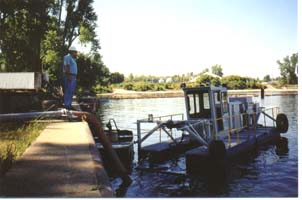
This little dredge boat removed tons of sediment containing 25,000
pounds of PCBs - about one quarter the amount to be removed from the
Hudson - over three summers. The Hudson River cleanup may require
several boats like this, and a small number of attendant barges - hardly
the vast destructive armada envisioned by GE.
-- Photo by Jim Gordon |
|
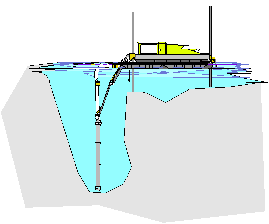
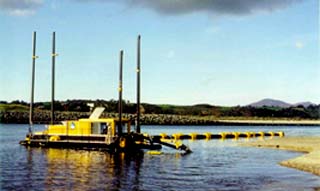
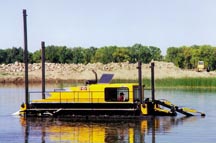
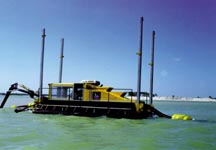
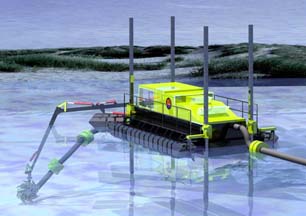
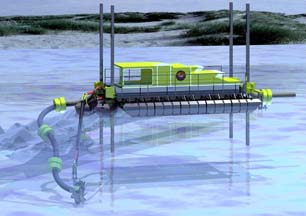
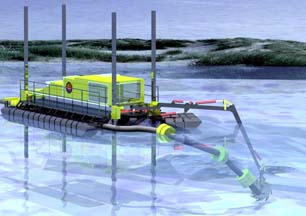 Environmental dredge graphics courtesy of Keene Engineering
Environmental dredge graphics courtesy of Keene Engineering